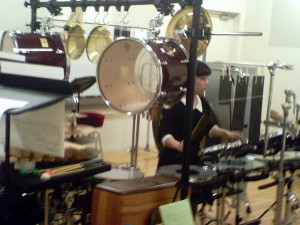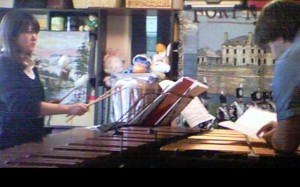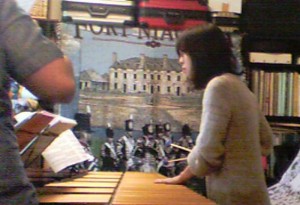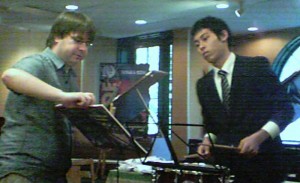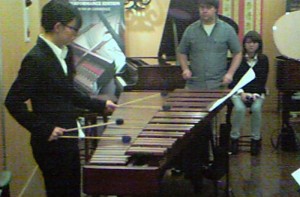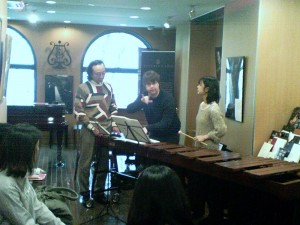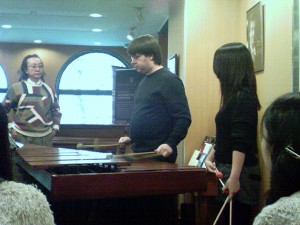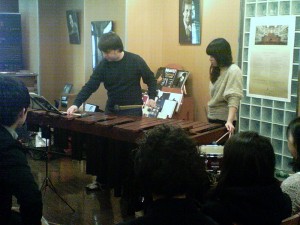Tuesday, Dec. 10
It was rainy and chilly this morning, and it’s a good thing that I packed an umbrella because the rain was strong at times during my short walk from the hotel to the school. I didn’t need to be at Showa until 10:15 so I worked on writing the previous blog entry and got it posted before heading out into the rain.
My entire morning at Showa was spent observing the percussion ensemble, which is comprised of 2nd and 3rd year students, and giving them my commentary on their performance. The ensemble is directed by the new full-time Professor of Percussion, Toshiaki Ichiuchi. The session was essentially a well prepared performance on my behalf, and basically they gave solid performances of three pieces.
– EXPLORATIONS IN TIME by Eckhard Kopetski (Percussion sextet)
– THE BIG DIPPER by Yoshuke Nomoto (Percussion ensemble – 8 players?)
– MUSIC FOR PIECES OF WOOD by Steve Reich (Tuned Claves quintet)
I made a few suggestions regarding placement of small instruments (tin cans, wood block) in the Kopetski. The piece is drummy in the beginning, quasi-misterioso in the middle and drummy again at the end. I suggested listening and playing more softly in the middle section.
The Nomoto piece was tonal with a tune and counterpoint in a kind of well-orchestrated pops concert style. It was performed very well and I had nothing to say, though Ichiuchi-sensei suggested that the players might smile once in a while, a suggestion which I seconded.
The Reich was played on five pairs of high pitched claves that were all very close in pitch (instead of specifically pitched as written), so the focus was mainly on the rhythm and maintaining concentration.
The session ended at 11:30, so Yashio suggested that instead of having lunch in the school cafeteria, that we go to il Campiello, the Italian restaurant right on the campus. After a relaxing lunch of spaghetti with meat sauce it was back to Showa for two afternoon lessons.
– CONCERTO FOR PERCUSSION, MTV. #4 by André Jolivet (Multi-perc, no. accomp.)
– DIFFERENT WAYS FOR SOLO TIMPANI by Eckhard Kopetski (Timpani solo, unaccompanied)
The issues in the Jolivet had largely to do with making an efficient setup and getting good sounds from the instruments while playing the rhythmic motifs precisely. The Kopetski piece has a number of imaginative and innovative sound ideas which make it a welcome addition to the literature for solo timpani. I suspect this piece will play a significant role in percussion recitals for lots of years to come.
At 5 PM I revisited the Showa English language class as in years past to be interviewed and videorecorded in conversational English. Each of the students asked a question in English to which I gave my response.
At 6 PM I walked over to the Vivre department store basement to buy some sushi to take back to my hotel room for dinner as I watched a BBC TV program (in English) on global warming.
As I finish this entry it’s likely that Mark Boseman has already started on his trip from Rochester to Yokohama. (More about Mark when I see him on Friday.)
Wednesday, Dec. 11
It was partly sunny and less chilly this morning but I haven’t been doing my power walking as I have done in all past visits. So far I’ve spent every morning and evening just writing on my laptop. There were six lessons today and the repertoire was:
– SUITE FOR PERCUSSION AND PIANO by Jean Aubain (Multi-perc, piano accomp.)
– PRISM by Keiko Abe (Marimba unaccompanied)
– FUGA from Violin Sonatas and Partitas by J.S. Bach (Marimba unaccompanied)
– ALL AMERICAN DRUMMER, Wilcoxin #132
– Hand drumming basics (djembes and congas)
– BLUES FOR GILBERT by Glentworth (Vibraphone unaccompanied)
– CONCERTO FOR PERCUSSION by Richard Rodney Bennett (Multi-perc, piano accomp.)
– Cajon basics (Cajons unaccompanied)
The students seemed to really enjoy the hand drumming and cajon patterns which are all presented in a drum circle format where a rhythmic pattern or cycle (Latin, African, Brazilian) is presented and copied in unison; then variations are presented and copied; and finally the entire group plays the basic pattern and one-by-one each player improvises over the pattern.
When I think about it this basic hand drumming and cajon experience may ultimately turn out to as valuable to most students as anything else in their study of percussion. It’s also a lot of fun and it exists in a nonjudgmental social setting of equals instead of a teacher/student hierarchy.
In general the performances of the multi-perc pieces have been greatly improved over past years. There have been virtually no gremlins (unintended rattles) and the instrument sounds have mostly been full-toned and resonant. I only had to remove a blanket from the pedal bass drum one time, and the pedal bass drum in the Aubain piece had a perfect (to my taste) undampened and full toned sound
I felt compelled to spend a lot of time on the history and background of the rudimental snare drum piece in order to convey some sense of the style, even though the students only use matched grip. In a technical sense the student played everything correctly, but without an understanding of the lilt of the music.
The issue in the vibraphone piece was mainly on using pedal dampening and stick dampening to achieve the desired phrasing.
And finally, the Bach “Fuga” generated some experimentation in trying to find the most convincing ways for the student to execute two of the internal cadences and the final two-bars. The decisions were to use strategic rolls on a few key notes at the top of certain arpeggiated chords, and at the cadences, to trill on the leading tone, with the upper-neighbor sounding first, and ending the trill with a gentle transition to a short roll on the leading tone before playing the cadence resolution tone(s). In the last measure the final chord would be played witha G/D appagiatura leading to a rolled Bb/G double-stop with a fermata crescendo ending on the G. It was generally agreed that these nuances best imitated the musical effect of violin bowings. I pointed out that while I completely agreed with these solutions, there are other performers who are vehemently opposed to any marimba rolls in the Bach unaccompanied violin and cello pieces.
Amazingly, as this writing comes to an end, I’m once again being entertained by the women’s curling tournament on TV.
Thursday, Dec. 12
Today started at 6:45 AM with an email from Erick Saoud, the percussion teacher from Arkansas. He was looking for information about Native American drums and rattles, so I googled a few websites and responded to his request. Then I had to get dressed a little formally – tie & jacket – because I had been asked to speak again to the Showa faculty and administration (about 200 people).
Beginning at 10 AM there were six lessons again today. The repertoire was:
– ALL AMERICAN DRUMMER, #37, #51, #125 (rudimental snare drum solo, unaccomp.)
– RHYTHM SONG by Paul Smadbeck (Marimba, unaccompanied)
– 85 EXERCISES FOR TIMPANI by Hofmeister (Timpani, unaccompanied)
– CONCERTINO FOR MARIMBA, Mvt. III by Paul Creston (Marimba, pno. accomp.)
– CAMÉLÉON by Eric Sammut (Marimba, unaccompanied)
– REBONDS B by Iannis Xenakis (Multi-percussion, unaccompanied)
– TOCCATA by Sigfried Fink (Snare drum, unaccompanied)
– MYRIADES by Francois Dupin (Timp./Multi-perc, piano accomp.)
The student – a senior – who played the Sammut piece had just won a competition in Japan and the performance was really fantastic. The others were freshmen and sophomores preparing for their January juries.
At lunchtime Kaz telephoned Fumiko (the translator) and invited us to the Italian restaurant (Trattoria) near my hotel to greet Mark Boseman, who arrived at Narita last night. Mark was nibbling on a slice of pizza when we walked in and he said he was really jetlagged. Kaz ordered two platters of Gnocchi with verde sauce and we all shared it along with the ham & cheese pizza slices.
Fumiko and I left the restaurant just in time to return to Showa for the 2 PM lesson, while Kaz and Mark headed back to Yokohama. I’ll be joining them in Yokohama on Saturday and Sunday. At 3:30 I had to give a brief address the faculty and administration and I decided to make it very short: “Hello; it’s nice to be back; the students are very good; thank you.”
I wasn’t hungry after school, probably because of the big lunch, so I thought I might just skip dinner, but around 9:30 PM I got a bit hungry, so I walked over to the convenience store in the train station and got a ham & cheese sandwich. Mark and I are invited to Sadanari’s tomorrow night for dinner, so Mark is in for an experience.
Friday, Dec, 13
It’s midnight and I just got back to the hotel room after the evening dinner at Sadanari’s which has become a regular part of my visits to Showa. I introduced Seichiro, Tokiko and Kungo (and their pup, Koko) to Mark Boseman, and we all had the usual good time. The sake flowed generously. Yashio reported that the students in Yokohama really enjoyed Mark’s lessons. About halfway through the evening Seichiro received a phonecall from Toru Saito of the Saito Marimba Company and Seichiro invited him to come over, which he did about 15-minutes later. We all shared stories and everyone kidded Seichiro about his “fantastic” chicken curry.
At 7 AM earlier the same day I began packing stuff in preparation for my checkout from the hotel in the morning. I’ll be transferring to Yokohama for two days to attend Mark Boseman’s sessions, but also because the hotel booked my room to a large wedding party (as has happened in years past). I headed over to school and from 10 AM there were 6 lessons again.
– CONCERTO FOR PERCUSSION by Andre Jolivet (Multi-perc, pno. accomp.)
– ETUDES FUR TIMPANI # 1 by Richard Hochrainer (Timpani, unaccompanied)
– ALL AMERICAN DRUMMER #33 (Snare drum, unaccompanied)
– REBONDS B by Iannis Xenakis (Multi-percussion, unaccompanied)
– TOCCATA by Mitch Markovich (Snare drum, unaccompanied)
– THE CASTLE OF THE MAD KING by Zivkovic (Multi-perc., unaccomp.)
The Zivkovic piece has a very large setup and is problematic on many fronts, not the least of which is its aesthetic – drumming gone wild. I actually met Zivkovic and heard him play this piece in Stockholm not long after it was composed (1998). It was while the war in Bosnia was still hot, and Zivkovic left me with the impression that he was very troubled and angry, an impression that this piece reinforces. I had to explain to the student that this piece is not about the usual stuff – sound, phrasing, tone, shape, accuracy, etc. Rather, it’s a theater piece in which the soloist literally performs as if in a mad frenzy. As the lesson ended, about ten of the Showa students entered the room and cleared out all of the huge Zivkovic setup in about 2-minutes – amazing.
After the last lesson we all adjourned to the band room for a quasi-concert featuring two of Kaz’s students as soloists with the wind ensemble. Koichiro played the CONCERTO FOR PERCUSSION by Jager and Noriko (the girl who visited Rochester with Kaz last March) played the first movement of the Creston. Both played very well and their performances were greeted by supportive hoots from fellow students – something that happens regularly back home, but I wouldn’t have expected it in Japan. Nevertheless, there it was.
Then a rush over to the department store to buy two bottles of German wine – an Auslese and an Icewein, and Kaz and I drove to Sadanari’s house in Machida at rush hour using all back streets and alleys as directed by his car’s GPS computer. The trip took about 45-minutes and it took us through the megalopolis corridor and into some very interesting neighborhoods. The narrow alleys, the winding streets and the patches of neon lights really drove home the feeling – now I know I’m in Japan.
Saturday, Dec. 14
I woke up at 8:30 after a good night’s sleep. (Must’ve been Sadanari’s sake!) I had to pack everything to check out of the hotel and Kaz picked me up at 10:30 for the 1-hour drive to Yokohama. It was a very clear and brisk day so along the drive I had a spectacular view of a perfectly snowcapped Mt. Fuji. We drove straight to Kaz’s house right next to the U.S. Naval Base and as soon as I got out of the car I heard marimba and vibraphone sounds coming from his window. Yashio came out to greet us and I walked in through the open front door to see Mark Boseman coaching Erika and Ayaka playing :
– CIRCLES OF ICE by Eckhard Kopetski (Marimba & Vibraphone duo)
Kaz’s living room had just enough space for the instruments,; it was tight, but not to the point of causing problems for anyone. There were also a few drums scattered around the room and a large Fort Niagara wall hanging behind the players that Kaz and Yashio had acquired on their first visit to Rochester. The marimba was Yashio’s Saito 5.0. The frame is something like the old Deagan frames but with square tubing rather than round, so it was very portable. The resonators were also much lighter, but they did the job very well – the low end bars sounded really good (with adjustable resonator tuning), even though the bars were just a bit thinner than other 5.0s. The overall sound of the marimba was “clean” and evenly voiced with a round centered tone; it reminds me very much of Ruth’s 4.0 Deagan.
After the coaching session, the girls packed up the instruments and put them into Kaz’s and Yashio’s cars and we all drove into central Yokohama to the Steinway piano studio where the girls unloaded the marimba and set it up again on the 3rd floor. We were met at the door by four of Kaz’s students from Kunitachi (who were going to play for Mark) and Saki and Honoka from Showa (who came to observe). Just before the masterclass began Toru Saito arrived. He’s the son of the Saito Company president and the company’s Marketing Director.
I met him last night at Sadanari’s, and we had talked briefly about his interest in introducing Saito marimbas into America. I told him that I think there is a market for good-quality, but less expensive 5.0 marimbas in the pre-college and education areas, and that an instrument like Yashio’s would fill the bill very nicely.
The four Kunitachi students (1st and 2nd year) started out on snare drum playing:
– ALL AMERICAN DRUMMER, #37, #51, #125 (rudimental snare drum solo, unaccomp.)
These were the same pieces I’ve been hearing all week at Showa, and they were played in the same way – technically correct, but without the stylings. Mark helped each one with rhythm and accents, and was clear from his execution that Mark has a field-music background. His commentary tended to focus on the precise execution of the rudiments. The drum was played throughout the session with snares off – understandable because of the nature of the music and also because of the relatively small, live room.
Next, the same four students played:
– SHADOW CHASER by Michael Burritt (Marimba unaccompanied)
– CONVERSATION by Miyoshi (Marimba unaccompanied)
– TWO PIECES FOR MARIMBA by Tanaka (Marimba unaccompanied)
The playing was very good and Mark helped them with inner phrasings and strokes, and his comments definitely improved their performances. After each of the four had played, Mark gave a short workshop on Stevens grip – having each of the students play double-stop strokes, independent stick strokes, and double lateral strokes (leading with inside and then outside).
The session ended at 5 PM and Kaz drove me to my hotel (Hotel Monterey Yokohama) the same hotel as in 2011. At 7 PM Kaz, Yashio and Mark arrived and we went down the street to a nearby Italian Restaurant (Roma Statione). Mark and I had Lasagna and it was very nice. After dinner Mark wanted to do a little shopping, so Kaz dropped us off at a huge shopping center called Queen’s Square on the harborfront. The mall was about a mile long, five-stories high with a center atrium, a circular escalator and absolutely packed with tens of thousands of shoppers. Mark wanted to find some interesting chopsticks to take back as gifts, and we located some in the department stores ranging from $6.50 to $24.00 a pair, but Mark decided to wait and come back again later.
The stores started closing down at 9 PM, so we left the mall on foot and walked a couple of blocks before separating to go to our hotels. (Mark is at the Hotel Washington.) My walk back to the Monterey was about a mile-and-a-half: easy.
Sunday, December 15
This morning I walked along the Yokohama harbor boulevard about a block away to a Jonathan’s Restaurant (like a Denny’s) for a breakfast of scrambled eggs, sausage, potato patties, toast and cafe latte. Kaz and Mark picked me up at 10:40 and we drove to the Steinway studio where I sat and observed Marks’ lessons until 4 PM. There were about 7 Showa students who came up to Yokohama by train, one Kunitachi student and Asami, a Showa graduate who came down from Tokyo. The sessions focused on:
– CONCERTINO FOR MARIMBA, Mvt. I by Paul Creston (Marimba, pno. accomp.)
– LIBERTANGO by Eric Sammut (Marimba, unaccompanied)
– RHYTHMIC CAPRICE by Leigh Howard Stevens (Marimba, unaccompanied)
– NOVEMBER EVENING by Christopher Norton (Marimba, unaccompanied)
– CONCERTO FOR MARIMBA by Eric Ewazen (Marimba, orch. accomp.)
– CARITAS by Michael Burritt (Marimba, unaccompanied)
– ALL AMERICAN DRUMMER, #37, #51, #125 (rudimental snare drum solo, unaccomp.)
After the last lesson we all – including students – walked around the corner to a fondue restaurant. Then I walked about a mile back to my hotel through Chinatown, which was all lit up in neon and crowded with busy restaurants and shoppers. Now I’m back in my room and I’ll do some writing. Tomorrow Kaz will pick me up at 8:30 AM for the drive back to the Molino Hotel and Showa, for a full day of teaching.
